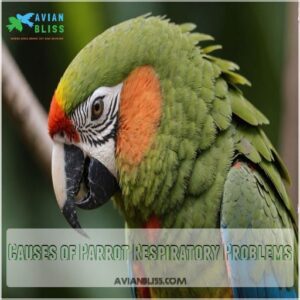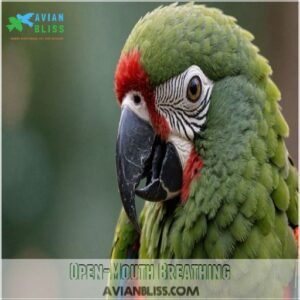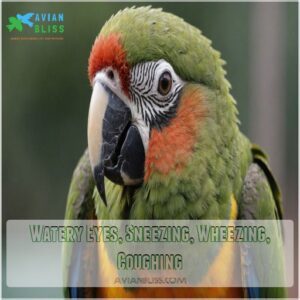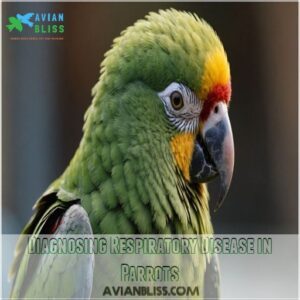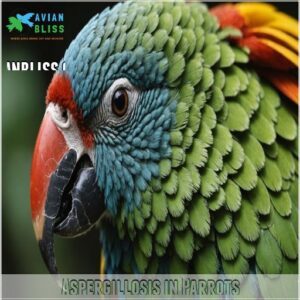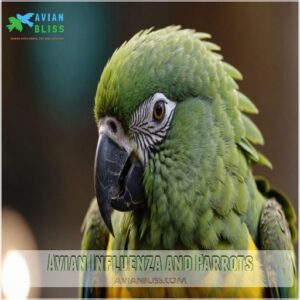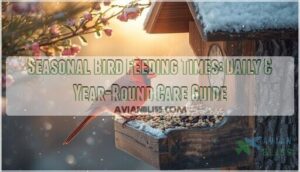This site is supported by our readers. We may earn a commission, at no cost to you, if you purchase through links.
 If your parrot’s wheezing sounds like an old accordion, it might have respiratory problems.
If your parrot’s wheezing sounds like an old accordion, it might have respiratory problems.
These issues often stem from infections, vitamin deficiencies, or environmental toxins.
You might notice symptoms like sneezing, coughing, or changes in your bird’s chirp.
Poor diet, especially low vitamin A, can leave its respiratory tract vulnerable.
Think of vitamin A as the bouncer keeping germs out.
Regular vet checkups and a clean, toxin-free environment help prevent these problems.
And remember, an ounce of prevention is worth a pound of squawking!
Curious about more tricks to keep Polly perky?
Stay tuned for some feather-ruffling insights!
Table Of Contents
- Key Takeaways
- Causes of Parrot Respiratory Problems
- Signs of Respiratory Disease in Parrots
- Diagnosing Respiratory Disease in Parrots
- Treating Respiratory Disease in Parrots
- Aspergillosis in Parrots
- Avian Influenza and Parrots
- Hypersensitivity Pneumonitis in Parrots
- Respiratory Parasites in Parrots
- Preventing Respiratory Problems in Parrots
- Frequently Asked Questions (FAQs)
- How do you treat a parrot respiratory infection?
- How can I help my bird with respiratory problems at home?
- How to tell if your bird has a respiratory infection?
- What are the symptoms of a respiratory infection?
- How do seasonal changes affect parrot respiratory health?
- Can stress influence parrot respiratory problems?
- Are specific parrot breeds more prone to respiratory issues?
- How does indoor air quality impact parrots?
- What role does exercise play in parrot respiratory health?
- Conclusion
Key Takeaways
- Keep your parrot’s diet balanced with plenty of vitamin-rich foods, avoiding an all-seed diet to protect its respiratory health.
- Maintain a clean, well-ventilated environment, steering clear of smoke and aerosols to prevent respiratory problems.
- Regular vet checkups are essential for early detection of respiratory issues, ensuring your bird stays healthy.
- Minimize stress through a calm habitat and mental stimulation to support your parrot’s overall well-being.
Causes of Parrot Respiratory Problems
You’re probably surprised to learn that your parrot’s wheeze could be due to anything from a shortage of vitamin A to airborne nasties like smoke or aerosols.
By understanding the common culprits behind these respiratory issues—bacteria, fungi, parasites, and environmental toxins—you can better safeguard your feathery friend’s health.
Vitamin a Deficiency
How can something as simple as diet lead to respiratory problems in parrots?
Vitamin A deficiency, often due to an all-seed diet, weakens your bird’s respiratory health.
Check for deficiency symptoms like sneezing and wheezing.
Find vitamin A sources like sweet potatoes, carrots, or supplements.
A bit of diet analysis might be all you need to breathe easy with your feathered friend.
Bacterial Infections
Nasty bacteria, like Mycoplasma and Chlamydia, can cause serious respiratory tract infections in your parrot. You’ll notice symptoms like sneezing and labored breathing.
Treatment options include antibiotics, but early bird respiratory diagnosis is key.
Prevention tips focus on hygiene and a clean environment. Remember, bird respiratory treatment needs a vet’s guidance to avoid antibiotic resistance and potential bird-to-human spread of some infections. Obesity in birds can lead to respiratory problems, so monitoring for signs like noticeable fat deposits is essential. Don’t delay—a healthy bird is a happy bird!
Fungal Infections
Breathing troubles in parrots can also come from sneaky fungal infections.
Aspergillosis, a notorious culprit, sneaks up on the immune system when conditions are just right—think damp environments with poor ventilation.
A sharp eye and swift action with fungal treatment options can curb these attacks.
Spotting respiratory infections in birds often requires financial support to cover expensive veterinary care, and investing in pet insurance for birds can help alleviate some of these costs. Spotting respiratory infections in birds means acting fast to support your feathered friend’s health.
Parasitic Infections
While dealing with parrot respiratory issues, note that parasitic infections often sneak up on the little guys.
Air sac mites, gapeworms, and sarcocystosis can cause major breathing troubles.
It’s like having unwanted guests in your home!
Treatment involves antiparasitic meds and prevention through good hygiene and proper ventilation.
Keeping these respiratory parasites at bay is essential for your feathered friend’s health.
Environmental Toxins
Imagine your parrot’s lungs craving clean air but getting a surprise attack from smoke, fumes, and sneaky hidden foes.
Non-stick cookware fumes, cleaning products, or air fresheners may seem harmless, yet they release allergens like feather dander and bird dust.
Keep pollutants at bay to dodge psittacosis or hypersensitivity pneumonitis.
Safe environments equal happy, healthy chirps!
Signs of Respiratory Disease in Parrots
When your parrot starts sounding more like a hoarse opera singer than its usual melodic self, it might be hinting at underlying respiratory woes.
Keep an eye out for signs like open-mouth breathing, wheezing, or sneezing, which could mean your feathered friend needs a visit to the vet.
Voice Change
Has your parrot suddenly changed its tune?
A voice change in your feathered friend might hint at a tracheal infection or other respiratory issues.
Keep an ear out for these avian respiratory symptoms, as they can affect syrinx health and vocal cords, impacting their lovely chatter.
Prompt attention to these signs can lead to effective parrot respiratory disease treatment.
Open-Mouth Breathing
Your parrot’s open-mouth breathing can be as concerning as a sudden voice change.
It’s often a sign of stress, dust exposure, or inadequate humidity levels.
Make sure your bird’s cage size allows for free movement and regularly check for dust buildup.
Open-mouth breathing signals potential parrot respiratory problems, like bird respiratory tract infections or sinus issues, needing prompt attention.
Difficulty Breathing
Open-mouth breathing can be a sign of trouble, but difficulty breathing is a more serious symptom of parrot respiratory issues.
Notice if your parrot’s breathing is labored or rapid.
This could indicate parrot lung problems, possibly even parrot asthma (or macaw asthma in macaws).
Seeking a vet’s diagnosis is key for effective treatment and prevention of further respiratory illness symptoms.
Early detection is important!
Watery Eyes, Sneezing, Wheezing, Coughing
Spotting watery eyes, sneezing, wheezing, or coughing in your parrot might ruffle your feathers a bit.
These signs could spell respiratory trouble, so keep your eyes peeled.
Catch these hints early and:
- Identify the cause: Check diet and environment.
- Home remedies: Increase humidity.
- When to see a vet: Persistent symptoms.
- Prevention tips: Keep their cage clean.
- Dealing with stress: Provide peace and quiet.
Diagnosing Respiratory Disease in Parrots
Diagnosing respiratory disease in parrots involves a mix of detective work and medical tests, much like solving a feathery mystery.
Your vet will perform a thorough physical exam, gather your bird’s history, and use tests like blood analysis and X-rays to get to the root of the problem.
Thorough Physical Examination
When you notice unusual bird behavior or odd respiratory sounds, a thorough physical exam becomes key.
Check for weight loss and other symptoms.
A vet will conduct an internal examination, looking for signs that could indicate parrot-related lung disease or avian influenza.
This step helps assess respiratory health risks quickly.
To aid in the diagnosis and treatment, specialized products for a Parrot Respiratory Exam may be necessary.
| Assessments | Symptoms | Concerns |
|---|---|---|
| Physical Exam | Weight Loss | Lung Disease |
| Internal Check | Respiratory Sounds | Avian Influenza |
| Behavioral Analysis | Odd Behavior | Other Health Risks |
History From Bird Owner
Your vet just wrapped up the exam, now let’s talk history. Understanding your parrot’s past is like solving a puzzle. Consider these questions: Your parrot’s unusual behavior might be linked to a more serious issue, such as decreased appetite signs.
- Bird’s diet? Was it balanced or more tacos and cookies? 2. Cage environment? Is it clean or cluttered? 3. Symptom duration? Days or weeks? 4. Travel history? Any exotic stops? Your insights can spot issues like aspergillosis early!
Blood Tests
Blood tests are invaluable in diagnosing respiratory diseases in parrots.
They evaluate red and white blood cell counts, indicating infections or vitamin A deficiency.
Understanding blood test results clarifies a bird’s health, suggesting possible lung disease or other risks.
Regular testing boosts accuracy, revealing hidden ailments.
So, think of blood tests as your parrot’s secret weapon for combating sneaky respiratory issues.
Radiographs
Understanding blood test results marks progress in diagnosing.
Now, let’s take X-rays, a powerful diagnostic tool in parrot respiratory care.
Radiographs reveal detailed images of the bird’s anatomy, exposing hidden issues within the lungs and air sacs.
This imaging technique helps veterinarians see that some parrot respiratory problems may be a result of internal cancers, such as those discussed in the context of avian cancer insights, offering insights into treatment options.
It’s like peeking inside, but without the mess!
Sinus Aspirate or Nasal Flush
Sometimes, even with X-rays, pinpointing a parrot’s respiratory problem remains tricky.
That’s where a sinus aspirate or nasal flush comes in handy.
It’s a simple procedure involving:
- Careful sample collection from the nasal passages.
- A gentle nasal flush technique to obtain a better sample.
- Sending the sample to a lab for analysis.
- Receiving results to guide treatment, improving diagnostic accuracy.
This helps you get your feathered friend back to their chirpy self!
Treating Respiratory Disease in Parrots
You’ve probably noticed that parrot respiratory issues require a thoughtful approach, using antibiotics, antifungal, and anti-parasitic drugs to tackle various infections.
Don’t underestimate the power of dietary correction and vitamin supplementation—your feathery friend might need hospitalization for severe cases (but they’ll be the talk of the ward with those vibrant plumes).
Antibiotics
Got a parrot with a respiratory itch? Antibiotics are often the go-to for tackling bacterial infections.
But beware! Use them wisely to avoid antibiotic resistance—a real feather-ruffler.
Keep an eye on dosage to dodge nasty antibiotic side effects.
Consider antibiotic alternatives for mild parrot-related lung disease.
Remember, it’s not just about treating; it’s about doing it right!
Antifungal Drugs
Dealing with fungal infections in parrots? Antifungal drugs are your go-to treatment options.
These meds, often given orally or via nebulization, can help clear pesky fungal invaders like Aspergillus.
When offering treats like popcorn as a reward during respiratory treatment, be mindful of the plain air-popped popcorn to avoid any choking hazards. But watch those drug side effects—always follow dosage guidelines to make sure your feathered friend’s safety.
Curious about effectiveness? Studies show promise, making these drugs a critical part of your parrot’s healthcare routine.
Anti-Parasitic Drugs
Switching gears from antifungal treatments, let’s tackle parasites.
Anti-parasitic drugs are key in clearing pesky invaders.
When considering treatment:
- Types of drugs vary—choose based on specific parasites.
- Be mindful of side effects like nausea or vomiting.
- Watch for drug resistance; that’s a challenge in repeat treatments.
Always follow dosage guidelines for your parrot’s safety.
Dietary Correction and Vitamin Supplementation
As the next step in your parrot’s recovery, addressing dietary needs can help immensely. An all-seed diet often lacks Vitamin A, essential for their respiratory health. Integrating a balanced mix of fruits, veggies, and supplements makes sure they’re getting the right nutrition.
| Nutrient | Benefit |
|---|---|
| Vitamin A | Respiratory Health |
| Supplement Types | Enhanced Immunity |
| Dosage Guidelines | Prevent Overdosing |
| Nutritional Balance | Overall Well-being |
Consider these changes for a healthier, happier bird!
Hospitalization
You’ve adjusted your parrot’s diet, but sometimes, hospitalization is the next step.
This might be due to severe respiratory issues such as Upper Respiratory Tract Infections (URTIs), requiring closer medical attention.
Your feathered friend might need this level of care for more intensive treatments.
Think about:
- Costs and duration: Hospitalization can quickly add up.
- Procedures and risks: Know what’s involved.
- Alternatives: Can other treatments work?
It’s like sending your bird on a spa retreat for recovery.
Aspergillosis in Parrots
Aspergillosis is a common fungal infection affecting parrots, often stemming from contaminated food or nesting materials.
You’ll want to watch for symptoms like labored breathing and loss of appetite, and remember prompt veterinary care is essential for the best outcome.
Sources of Infection
Poor cage hygiene and water contamination can make your bird’s home an unwelcome bacterial playground.
You can also find products to aid in the treatment and prevention of aspergillosis, such as those found in aspergillosis treatment.
Bird contact isn’t always friendly; it can spread fungal spores faster than you’d think.
Keeping an eye out for dust mites is also a good habit—they’re more than just pesky house guests.
Signs of Infection
From contaminated food and nesting materials, Aspergillosis triggers parrot respiratory problems with noticeable signs.
Watch for labored breathing, sneezing, and wheezing.
Nasal discharge might make you think your bird’s fighting a cold, but it’s more serious.
Keep an eye out for these signs of infection:
- Labored breathing
- Lethargy and appetite loss
- Nasal discharge
Being aware can help prevent serious issues.
Treatment and Prevention
Notice your parrot’s labored breathing recently?
Treating aspergillosis requires oral antifungal drugs and improving air quality.
Think regular cage cleaning and enhanced ventilation—an exhaust fan works wonders.
Keep stress levels low with familiar environments.
Don’t forget the avian vet care; they’re your trusty sidekick.
A balanced diet with proper supplements supports recovery and boosts respiratory hygiene, reducing future risks.
Avian Influenza and Parrots
Regarding avian influenza, knowing how it affects your feathery friend can be a lifesaver.
These viral infections are rare but can be transmitted from wild birds, so understanding the risks and preventive measures is essential for keeping your parrot healthy and happy.
Transmission and Risk Factors
After exploring aspergillosis, let’s tackle avian influenza.
Bird flu risk in parrots involves parrot-to-human transmission, heavily influenced by indoor air quality and stress levels.
Keeping your feathery friend safe requires vigilance against infections.
- Protect your family and parrots
- Maintain clean habitats
- Reduce stress and boost immunity
- Regular vet check-ups are a must
- Watch for feather dander allergies
Clinical Signs and Diagnosis
Spotting signs of Avian Influenza in parrots might seem tricky, but it’s important.
Watch for respiratory distress, and examine for sneezing or nasal discharge.
For a more accurate diagnosis, it’s also important to take into account results from an Avian Flu Test.
A physical examination combined with diagnostic imaging like X-rays, history taking, and laboratory tests can confirm the diagnosis.
| Symptom | Diagnostic Method |
|---|---|
| Respiratory Distress | Physical Exam |
| Nasal Discharge | Lab Tests |
| Sneezing | History Taking |
| Loss of Appetite | Radiographs |
Prevention Measures
Knowing the signs of avian influenza is half the battle; preventing it’s the other half.
Good cage hygiene is key—think of it as your parrot’s personal spa day!
A balanced diet helps boost their immune system, reducing their vulnerability.
Regular vet visits are like preventative maintenance for your feathered friend.
- Maintain impeccable cage hygiene.
- Provide a nutritious diet.
- Schedule regular checkups with your avian vet.
Hypersensitivity Pneumonitis in Parrots
You’ve probably heard of macaw asthma, but did you know it’s actually called hypersensitivity pneumonitis?
This condition, often triggered by dust and bird droppings, can cause significant respiratory distress in parrots, especially if your flighty friend lacks proper ventilation.
Causes and Risk Factors
Los Angeles to Long Beach’s beaches.
Now, let’s chat about parrot respiratory risks.
Hypersensitivity pneumonitis, often called "parrot fever," can sneak up on you, especially in poorly ventilated spaces where parrot feather dander floats about.
Common household aerosols like air fresheners and scented candles can also pose a threat to your parrot’s health.
A dash of cage hygiene keeps air quality in check.
Don’t forget, stress levels and pre-existing conditions play their part.
Keep it fresh; keep it healthy!
Signs and Symptoms
Imagine you’ve got a parrot showing unusual breathing patterns. It might be hypersensitivity pneumonitis.
Look for:
- A frequent cough and nasal discharge that doesn’t quit.
- Feather ruffling, as if your bird is having a bad feather day.
- A sudden loss of appetite, even for its favorite treat.
Stay alert to these signs and keep your feathery friend safe.
Treatment and Management
Noticing breathing troubles? You might face Hypersensitivity Pneumonitis.
Start with oxygen therapy and medication options like glucocorticoids.
Keep your feathered friend comfortable with lifestyle changes and preventive measures.
Good air quality is a must—think of a high-quality filter and proper ventilation.
You’re set for long-term management with these tips. Let’s keep that squawker healthy!
| Treatment | Description |
|---|---|
| Oxygen Therapy | Helps ease breathing difficulties |
| Glucocorticoids | Reduces inflammation |
| Air Quality | Improves overall respiratory health |
| Lifestyle Changes | Enhances living conditions |
Respiratory Parasites in Parrots
When your parrot starts sounding more like a winded accordion, respiratory parasites might be to blame.
These pesky invaders, like air sac mites and gapeworms, can cause serious breathing issues but are treatable with the right care and a little patience.
Air Sac Mites
Dealing with air sac mites can be like untangling spaghetti.
These pesky parasites invade the respiratory tract, causing coughing and labored breathing in your parrot.
Their presence disrupts the parrot’s unique unidirectional airflow system, which relies on a network of loop-shaped airways and air sacs that work together to direct air flow, as seen in bird respiratory system.
Spot them through symptoms like rasping noises.
Effective air sac mite treatment involves antiparasitic drugs.
Prevent further invasion by maintaining a clean cage and prompt vet checkups.
Keep those squawkers breathing easy!
Gapeworms
Another common respiratory parasite is the gapeworm.
These nasty critters live in your parrot’s trachea, causing coughing and gasping for air.
Gapeworm identification often involves a vet checking your bird’s throat.
Treatment usually involves medication.
Prevention focuses on good hygiene and parasite control.
Let’s look at some common symptoms:
- That heartbreaking cough.
- Difficulty breathing, poor little guy.
- A noticeable loss of appetite.
- Lethargy and weakness.
- Open-mouth breathing.
Sarcocystosis
Imagine Sarcocystosis as a sneaky parasite party crashing your parrot’s respiratory tract.
This pesky protozoan finesse cysts into their tissue, causing symptoms like difficulty breathing and fatigue.
To prevent Sarcocystosis transmission, maintain hygiene, offer clean food, and provide good ventilation.
Sarcocystosis diagnosis requires a vet’s expertise, and treatment involves anti-protozoal meds.
Stay vigilant and keep your feathered friend parasite-free!
Preventing Respiratory Problems in Parrots
To keep your parrot breathing easy and squawk-free, focus on a balanced diet, a clean environment, and regular vet visits.
Avoiding toxins and minimizing stress will play a key role in your feathered friend’s respiratory health—even if they’re convinced that vacuum cleaners are just misunderstood beasts.
Providing a Balanced Diet
Spotting a mite problem might make you anxious, but adjusting your parrot’s diet can set things right.
Seed-free diets are a great start to combat nutritional deficiencies.
Fresh food choices and pellet benefits balance their needs, while vitamin supplements play a key role.
Your feathered friend’s health drastically improves when the menu mimics nature’s palette – a rainbow of nutrition-packed options.
Maintaining a Clean Environment
Keeping your parrot healthy is as easy as keeping their space clean. Here’s your checklist:
- Cage cleaning: Do it weekly to nix germs.
- Air quality: Get a HEPA filter to zap dust.
- Disinfection: Use bird-safe disinfectants regularly.
- Ventilation: Make sure there’s good airflow with open windows or fans.
These steps help control dust and boost wellness!
Avoiding Exposure to Toxins
You’re already keeping their space clean, now let’s keep harmful stuff at bay.
Non-stick cookware, air fresheners, and household cleaners can secretly harm your feathery friend.
Plus, cigarettes and paint fumes spell trouble for their lungs.
Swap harsh chemicals for bird-safe options.
Your parrot will thank you with cheerful chirps and not-so-polite squawks if you ignore this advice!
Minimizing Stress
Creating a stress-free environment for your parrot helps prevent respiratory problems.
Provide safe spaces and make sure they’ve quiet time to relax.
Observe bird behavior to gauge their comfort level.
Enrichment activities keep them mentally stimulated, like puzzle toys or gentle music.
Remember, a relaxed parrot is a healthier parrot, as minimal stress can improve their overall well-being.
Regular Veterinary Checkups
With preventative care, you’ll keep your feathered friend in top shape.
Regular vet visits are key for early detection of potential problems.
Think of it as a tune-up for your parrot’s health.
Routine exams allow your vet to spot subtle signs of respiratory issues before they become serious.
These checkups are a small investment in your bird’s long-term well-being and peace of mind.
Don’t delay; schedule those bird health appointments!
Frequently Asked Questions (FAQs)
How do you treat a parrot respiratory infection?
Just like treating a stubborn cold, address your parrot’s respiratory infection with antibiotics for bacterial causes or antifungal meds for fungal issues.
Make sure you provide a balanced diet and a stress-free environment, and consult your vet for specific guidance.
How can I help my bird with respiratory problems at home?
Make sure your bird has a clean, stress-free environment with proper ventilation.
Regularly clean its cage, offer a balanced diet, and avoid smoke and aerosols.
Consult a vet if symptoms persist or worsen, making sure timely professional care is received.
How to tell if your bird has a respiratory infection?
Spotting respiratory infection in birds is like noticing your car’s sputtering engine.
Watch for symptoms like open-mouth breathing, voice changes, wheezing, nasal discharge, and sneezing.
If your bird shows these signs, consult a vet promptly.
What are the symptoms of a respiratory infection?
You’re in the know if you spot symptoms like wheezing, sneezing, and open-mouth breathing in your bird.
Watch for watery eyes, nasal discharge, voice changes, and difficulty perching too.
Maintaining a balanced diet rich in nutrients like chia seeds for birds, can support your parrot’s overall health. Swift action keeps your feathered friend healthy!
How do seasonal changes affect parrot respiratory health?
Sudden temperature drops weaken your parrot’s immune system, making them more vulnerable to respiratory illnesses.
Keep their environment stable and warm, especially during seasonal changes.
A comfy, consistent climate helps them thrive!
Can stress influence parrot respiratory problems?
Stress plays a significant role in parrot respiratory issues by weakening their immune system.
When your feathered friend feels stressed, they become more vulnerable to infections.
Keep their environment calm and stable to boost their health.
Are specific parrot breeds more prone to respiratory issues?
Parrot species like Blue and Gold macaws, which are among the very large parrot species, and African greys often face respiratory issues – about 20% more than others.
Ensuring proper ventilation and balanced diets can help minimize risks.
Think of it as prevention meets parrot pampering!
How does indoor air quality impact parrots?
Indoor air quality can hugely affect your parrot’s health.
Poor ventilation and airborne irritants like dust or chemicals may lead to respiratory issues.
Make sure there’s good airflow, minimize pollutants, and clean regularly to keep them healthy.
What role does exercise play in parrot respiratory health?
Exercise is a great way to revitalize parrots, boosting their lung capacity and overall health.
Daily activity prevents weight gain, promotes circulation, and enhances respiratory efficiency.
Keep your feathered friend moving with toys and flight time.
Conclusion
Imagine your parrot’s health like a fragile feather: small tears could mean big troubles.
Addressing parrot respiratory problems is about vigilance and proactive care.
Identify symptoms early—like coughing or wheezing—and seek veterinary advice.
A balanced diet rich in vitamin A and a toxin-free environment serve as your bird’s best bouncers against illness.
Regular checkups, clean living spaces, and stress reduction are key.
With attentive care, you’ll keep Polly’s lungs—and chirp—healthy and strong.

